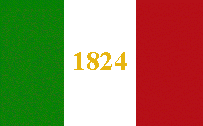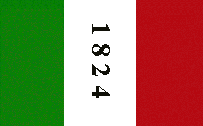
In addition, these variations were not limited to the contemporaries
of the revolution. When H. A. McArdle was researching his painting "Dawn
at the Alamo", which now hangs in the Texas Legislature, he did extensive
research into all details of the era. In his preliminary sketch of the
flag, the numerals are a gold or yellow color. His notes do not reveal
where he obtained the information that the numerals were gold and the rendering
of the numerals in gold may have simply been artistic license. In the original
ordinance, however, no specific numeral color was mentioned. I suppose
it would be equally accurate to color the numerals blue. In still another
variation, in McArdle's final painting the numerals are in black and written
vertically on the white bar.

Shortly after the Storming of Bexar, Phillip Dimmit was one of those
who changed their mind about reconciling with Mexico and by the time he
left for Goliad in early December, 1835, he was firmly for an independent
Texas. We do not know whether he left his original flag in Bexar or took
it with him to Goliad. We do know that shortly after Dimmit left Bexar,
Dr. James Grant and Col. F.W. Johnson who were in Bexar at the time, started
using an 1824 flag. Did Dimmit give his flag to Grant and Johnson? Probably
not. The animosity between Grant and Dimmit was well known and usually
quite evident. Dimmit may have abandoned the flag in Bexar to be usurped
by Grant or he may have destroyed the flag on his way to Goliad. Whichever
took place, by the time he reestablished his commandancy of Goliad he had
abandoned the 1824 Flag and was using a white flag with a bloody arm holding
a sword as his banner. This banner was adopted to celebrate the signing
of an unsanctioned Declaration of Independence at Goliad on December 20,
1835. Much to the chagrin of the plodding Texas provisional government,
the colonists were beginning to adopt a much more militant stance toward
the established Mexican government.